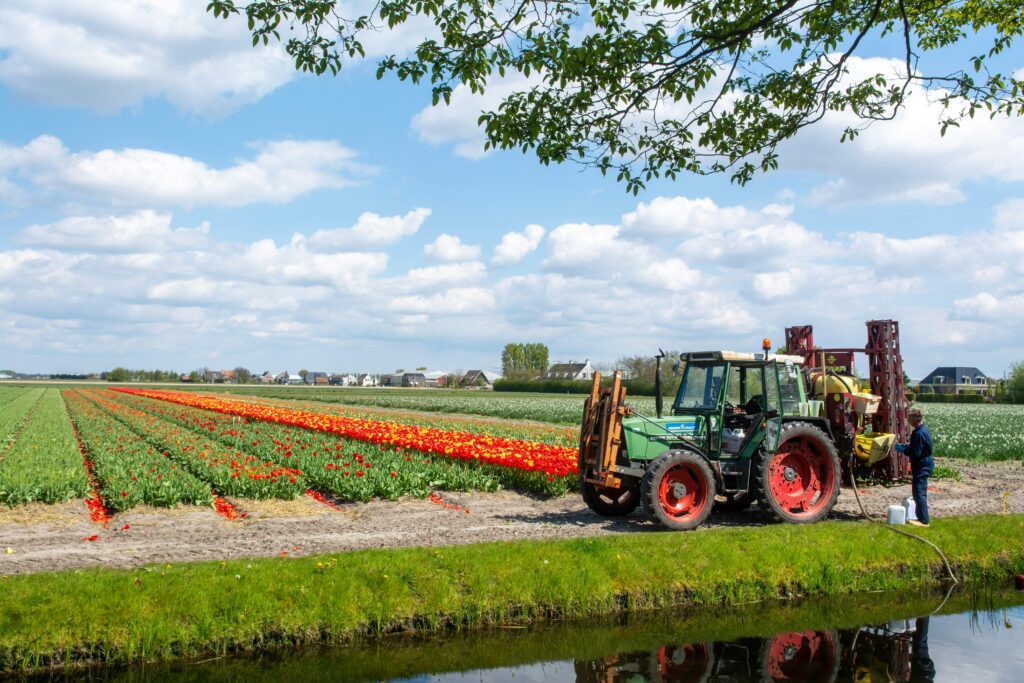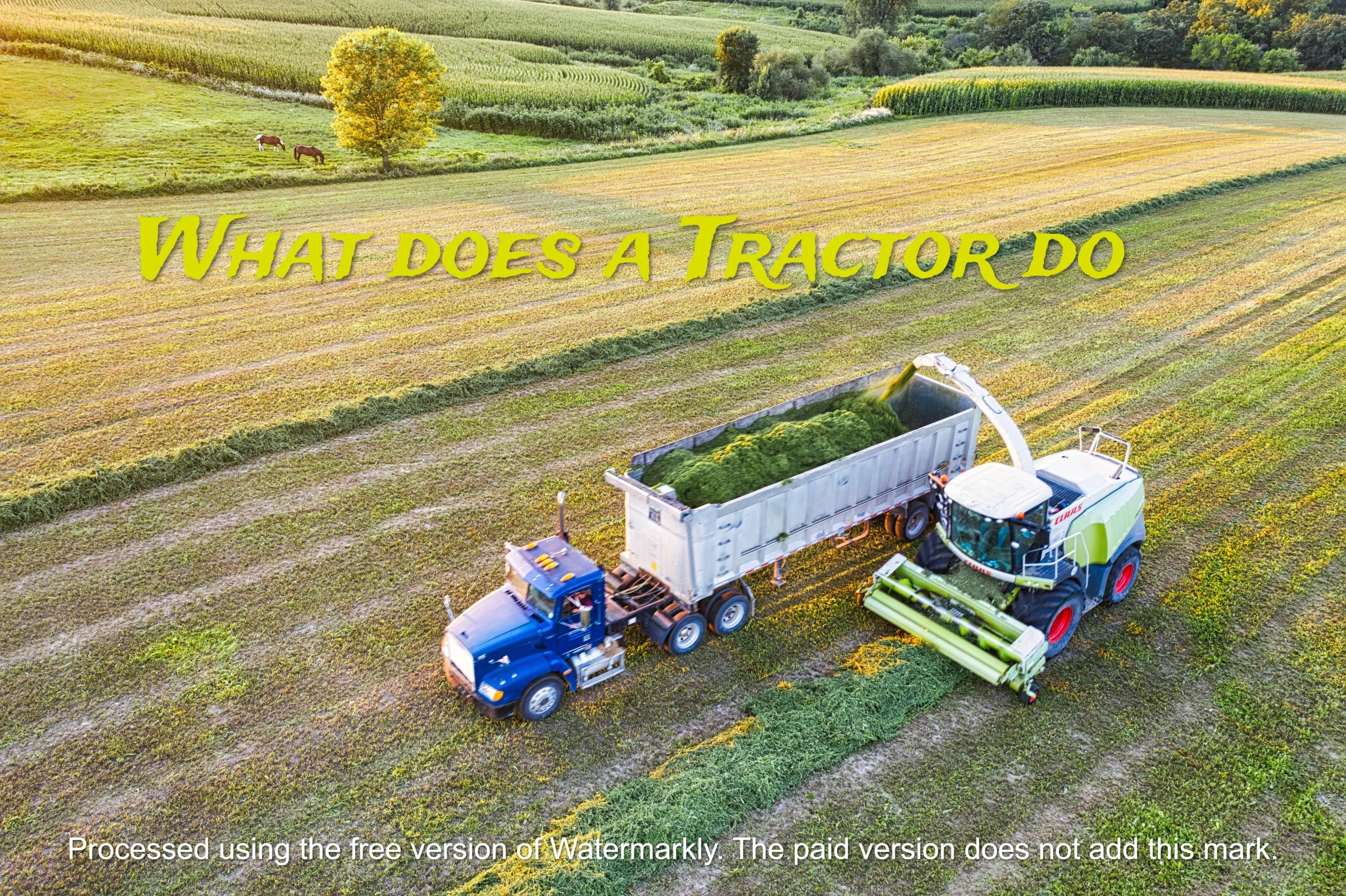A tractor is a powerful agricultural vehicle used primarily for hauling heavy machinery, plowing fields, and other tasks involved in farming. It typically has large rear wheels to provide traction and may have attachments like plows, cultivators, or trailers for various agricultural activities. Tractors play a crucial role in modern farming by increasing efficiency and productivity.
Introduction
Tractors, those mighty machines on wheels, have become an indispensable part of modern agriculture, construction, and various other industries. From tilling the soil and planting crops to hauling heavy loads and clearing debris, these powerful workhorses play a vital role in numerous tasks. But what exactly does a tractor do? This comprehensive guide aims to shed light on the diverse functions and applications of tractors, exploring their evolution, types, and the specific roles they play in different sectors.
Understanding the Tractor’s Origins
Before delving into the multitude of tasks tractors perform, it’s essential to understand their historical roots. The concept of a self-propelled vehicle for agricultural purposes dates back to the late 19th century when steam-powered tractors first emerged. However, it wasn’t until the early 20th century that gasoline-powered tractors began to gain widespread popularity, revolutionizing the way farms operated.
The Advent of Modern Tractors
The introduction of the Fordson Model F in 1917 marked a significant milestone in tractor design and manufacturing. This affordable and reliable machine paved the way for the widespread adoption of tractors in agriculture, replacing draft animals and human labor for many arduous tasks. Over time, advances in technology and engineering led to the development of more powerful, efficient, and versatile tractors, capable of tackling a vast array of applications.
The Multifaceted Roles of Tractors
Tractors have evolved from simple plowing machines to versatile powerhouses, capable of performing a multitude of tasks across various industries. Let’s explore the primary roles and applications of these indispensable machines.
Agriculture: The Backbone of Farming Operations
In the agricultural realm, tractors serve as the backbone of farming operations, playing a crucial role in numerous tasks:
Tillage and Seedbed Preparation
One of the primary functions of tractors in agriculture is soil preparation. By attaching implements like plows, disc harrows, and cultivators, tractors can effectively till the soil, breaking up compacted earth and creating a suitable seedbed for planting crops.
Planting and Seeding

Tractors are instrumental in the planting process, as they can be equipped with various seeding and planting implements. From row crop planters to grain drills, these machines ensure precise seed placement and efficient planting operations.
Crop Maintenance
Throughout the growing season, tractors are essential for crop maintenance tasks such as fertilizing, spraying pesticides and herbicides, and mowing or trimming crops. Specialized attachments like sprayers, spreaders, and mowers enable efficient and accurate application of necessary inputs.
Harvesting

When crops are ready for harvest, tractors take center stage once again. By attaching implements like combines, balers, and forage harvesters, tractors play a vital role in the harvesting process, ensuring efficient and timely collection of various agricultural products.
Construction and Landscaping: Versatile Earth Movers

Beyond agriculture, tractors have found their way into the construction and landscaping industries, where their versatility and power are highly valued.
Site Preparation and Grading
In construction projects, tractors equipped with attachments like bulldozer blades, graders, and box scrapers can level and grade sites, preparing them for building foundations or landscaping endeavors.
Material Handling
Equipped with front-end loaders or backhoes, tractors can efficiently move and transport materials like soil, gravel, and debris, making them invaluable assets on construction sites and landscaping projects.
Digging and Trenching
Tractors with backhoe attachments can dig trenches for utility lines, foundations, or drainage systems, showcasing their versatility in earthmoving operations.
Landscaping and Maintenance
In the realm of landscaping, tractors can be outfitted with mowers, tillers, and other attachments, enabling tasks such as lawn maintenance, garden bed preparation, and general landscaping duties.
Industrial and Utility Applications
The versatility of tractors extends beyond agriculture and construction, with various industrial and utility applications:
Snow Removal
In regions with heavy snowfall, tractors can be equipped with snowplows or blowers, making them essential for clearing roads, driveways, and other areas during winter months.
Logging and Forestry
In the forestry industry, tractors play a vital role in skidding logs, clearing brush, and maintaining access roads, enabling efficient timber harvesting and management operations.
Emergency Response
During natural disasters or emergencies, tractors can be invaluable assets for debris removal, search and rescue operations, and transporting supplies to affected areas.
Specialized Tasks
With the availability of numerous attachments and implements, tractors can tackle a wide range of specialized tasks, such as trenching, ground leveling, and even powering auxiliary equipment like generators or pumps.
Types of Tractors: Tailored for Specific Needs
To accommodate the diverse range of applications and industries, tractors come in various sizes, configurations, and power ratings. Here are some of the most common types:
Utility Tractors
Utility tractors, also known as compact or lawn and garden tractors, are smaller and more maneuverable, making them ideal for residential or light commercial applications like landscaping, small-scale farming, and general property maintenance.
Row Crop Tractors
Designed specifically for agricultural purposes, row crop tractors feature a narrow wheelbase and high clearance, enabling them to navigate between rows of crops with ease. These tractors are essential for tasks like planting, cultivating, and harvesting row crops.
Orchard Tractors
As the name suggests, orchard tractors are specially designed for use in orchards and vineyards. Their compact size and low profile allow them to maneuver through tight spaces, making them suitable for tasks like pruning, spraying, and harvesting in these specialized agricultural settings.
Industrial Tractors
Industrial tractors, also known as construction or earthmoving tractors, are powerful and rugged machines built to handle heavy-duty tasks like grading, excavation, and material handling. These tractors are commonly found on construction sites, quarries, and mines.
Articulated Tractors
Articulated tractors feature a unique design with a pivot point between the front and rear sections, allowing for exceptional maneuverability and stability on uneven terrain. These tractors are commonly used in construction, forestry, and agricultural applications where navigating challenging landscapes is necessary.
Advanced Features and Technologies
As tractors continue to evolve, they are incorporating advanced features and technologies to enhance their performance, efficiency, and operator comfort:
Precision Farming Technologies
Precision farming technologies, such as GPS guidance systems, variable rate technology (VRT), and yield mapping, are increasingly being integrated into modern tractors. These technologies enable precise and efficient application of inputs, minimizing waste and maximizing yields.
Telematics and Remote Monitoring
Many tractors now feature telematics systems that allow for remote monitoring and data collection. This technology provides valuable insights into machinery performance, maintenance needs, and operational efficiency, enabling better decision-making and resource management.
Autonomous and Semi-Autonomous Operation
The agriculture industry is embracing the concept of autonomous and semi-autonomous tractors, which can operate with minimal or no human intervention. These advanced systems rely on GPS, sensors, and AI algorithms to navigate fields, perform tasks, and optimize operations, reducing labor requirements and increasing efficiency.
Improved Operator Comfort and Safety
Modern tractors prioritize operator comfort and safety, featuring ergonomic cabs, air conditioning, suspension systems, and advanced safety features like rollover protection structures (ROPS) and backup cameras. These enhancements contribute to increased productivity and reduced operator fatigue.
Fuel Efficiency and Emission Reduction
Manufacturers are continuously working to improve the fuel efficiency and reduce emissions of tractors, driven by environmental concerns and the need for cost-effective operations. This is achieved through advancements in engine technology, aerodynamics, and the incorporation of alternative fuel sources like biofuels and electric powertrains.
Tractor Maintenance and Longevity
To ensure optimal performance and longevity, proper maintenance of tractors is crucial. Regular servicing, such as oil changes, filter replacements, and adherence to recommended maintenance schedules, can significantly extend the lifespan of a tractor and prevent costly breakdowns or repairs.
Additionally, proper storage and handling practices, including protecting tractors from harsh weather conditions and avoiding overloading or misuse, can further contribute to their longevity and reliable operation.

Tables
Table 1: Tractor Types and Applications
| Tractor Type | Primary Applications |
|---|---|
| Utility Tractors | Landscaping, small-scale farming, property maintenance |
| Row Crop Tractors | Planting, cultivating, and harvesting row crops |
| Orchard Tractors | Pruning, spraying, and harvesting in orchards and vineyards |
| Industrial Tractors | Grading, excavation, material handling on construction sites |
| Articulated Tractors | Construction, forestry, agriculture on uneven terrain |
Table 2: Tractor Maintenance Checklist
| Maintenance Task | Frequency |
|---|---|
| Engine oil and filter change | Every 200-300 hours |
| Air filter replacement | Every 500-1000 hours |
| Coolant system flush | Annually or as recommended |
| Brake inspection and adjustment | Every 500 hours |
| Tire pressure and condition check | Monthly or as needed |
| Lubrication of all grease fittings | Every 100 hours |
| Battery inspection and maintenance | Annually or as needed |
Remember, this is a general guideline, and it’s essential to consult your tractor’s owner’s manual for specific maintenance recommendations and schedules.
Conclusion
Tractors have come a long way from their humble beginnings as simple plowing machines. Today, these versatile and powerful workhorses play a vital role in a multitude of industries, from agriculture and construction to landscaping and forestry. With their ability to tackle a diverse range of tasks and their ever-evolving technological advancements, tractors have solidified their position as indispensable tools in modern society.
As we look to the future, the role of tractors is likely to expand even further, with the integration of cutting-edge technologies like autonomous operation, advanced telematics, and alternative fuel sources. These innovations will not only enhance efficiency and productivity but also contribute to sustainable practices and environmental stewardship.
Whether tilling the soil, hauling heavy loads, or clearing debris, tractors have proven their worth time and again. As our understanding of their capabilities grows, we can expect these mighty machines to continue revolutionizing the way we work and shape the landscapes around us.
FAQs
- What are the primary functions of tractors in agriculture? Tractors play a crucial role in various agricultural tasks, including soil preparation (tillage and seedbed preparation), planting and seeding, crop maintenance (fertilizing, spraying, and mowing), and harvesting. They are indispensable tools for efficient and productive farming operations.
- How do tractors contribute to construction and landscaping projects? In the construction and landscaping industries, tractors are invaluable for site preparation and grading, material handling (moving soil, gravel, and debris), digging and trenching, and landscaping and maintenance tasks like lawn mowing and garden bed preparation.
- What are the different types of tractors, and what are their specific applications? Some common types of tractors include utility tractors (for residential and light commercial use), row crop tractors (for planting, cultivating, and harvesting row crops), orchard tractors (for use in orchards and vineyards), industrial tractors (for construction and earthmoving), and articulated tractors (for improved maneuverability on uneven terrain).
- What are some of the advanced features and technologies found in modern tractors? Modern tractors incorporate precision farming technologies (GPS guidance, variable rate technology, yield mapping), telematics and remote monitoring systems, autonomous and semi-autonomous operation capabilities, improved operator comfort and safety features, and advancements in fuel efficiency and emission reduction.
- How important is proper maintenance for tractors? Proper maintenance, including regular servicing, adherence to maintenance schedules, and proper storage and handling practices, is crucial for ensuring optimal performance, longevity, and reliable operation of tractors. Neglecting maintenance can lead to costly breakdowns or repairs and reduced lifespan.
